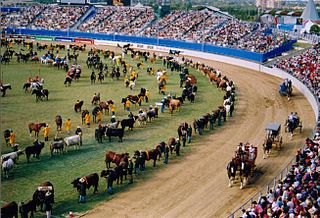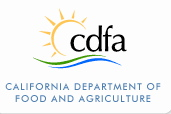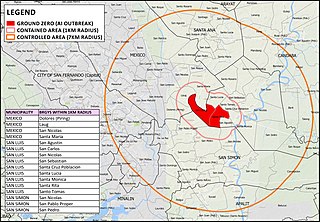Brucellosis is a highly contagious zoonosis caused by ingestion of unpasteurized milk or undercooked meat from infected animals, or close contact with their secretions. It is also known as undulant fever, Malta fever, and Mediterranean fever.

Avian influenza, known informally as avian flu or bird flu, is a variety of influenza caused by viruses adapted to birds. The type with the greatest risk is highly pathogenic avian influenza (HPAI). Bird flu is similar to swine flu, dog flu, horse flu and human flu as an illness caused by strains of influenza viruses that have adapted to a specific host. Out of the three types of influenza viruses, influenza A virus is a zoonotic infection with a natural reservoir almost entirely in birds. Avian influenza, for most purposes, refers to the influenza A virus.

Influenza A virus subtype H5N1 (A/H5N1) is a subtype of the influenza A virus which can cause illness in humans and many other animal species. A bird-adapted strain of H5N1, called HPAI A(H5N1) for highly pathogenic avian influenza virus of type A of subtype H5N1, is the highly pathogenic causative agent of H5N1 flu, commonly known as avian influenza. It is enzootic in many bird populations, especially in Southeast Asia. One strain of HPAI A(H5N1) is spreading globally after first appearing in Asia. It is epizootic and panzootic, killing tens of millions of birds and spurring the culling of hundreds of millions of others to stem its spread. Many references to "bird flu" and H5N1 in the popular media refer to this strain.

An agricultural show is a public event exhibiting the equipment, animals, sports and recreation associated with agriculture and animal husbandry. The largest comprise a livestock show, a trade fair, competitions, and entertainment. The work and practices of farmers, animal fanciers, cowboys, and zoologists may be displayed. The terms agricultural show and livestock show are synonymous with the North American terms county fair and state fair.
The meat industry are the people and companies engaged in modern industrialized livestock agriculture for the production, packing, preservation and marketing of meat. In economics, the meat industry is a fusion of primary (agriculture) and secondary (industry) activity and hard to characterize strictly in terms of either one alone. The greater part of the meat industry is the meat packing industry – the segment that handles the slaughtering, processing, packaging, and distribution of animals such as poultry, cattle, pigs, sheep and other livestock.

H5 N2 is a subtype of the species Influenzavirus A. The subtype infects a wide variety of birds, including chickens, ducks, turkeys, falcons, and ostriches. Affected birds usually do not appear ill, and the disease is often mild as avian influenza viral subtypes go. Some variants of the subtype are much more pathogenic than others, and outbreaks of "high-path" H5N2 result in the culling of thousands of birds in poultry farms from time to time. It appears that people who work with birds can be infected by the virus, but suffer hardly any noticeable health effects. Even people exposed to the highly pathogenic H5N2 variety that killed ostrich chicks in South Africa only seem to have developed conjunctivitis, or a perhaps a mild respiratory illness. There is no evidence of human-to-human spread of H5N2. On November 12, 2005 it was reported that a falcon was found to have H5N2.

The California Department of Food and Agriculture (CDFA) is a cabinet-level agency in the government of California. Established in 1919 by the California State Legislature and signed into law by Governor William Stephens, the Department of Food and Agriculture is responsible for ensuring the state's food safety, the protection of the state's agriculture from invasive species, and promoting the California agricultural industry.
President Chester A. Arthur signed the Animal Industry Act on May 29, 1884 creating the Bureau of Animal Industry (BAI), an organization that was established under the United States Department of Agriculture. It replaced the Veterinary Division that had been created by the Commissioner of Agriculture in 1883, which had taken over for the Treasury Cattle Commission, Department of Treasury.

The National Livestock Identification System (NLIS) is a livestock identification and tracking system used in Australia. It is administered by Integrity Systems Company, which is a wholly owned subsidiary of Meat and Livestock Australia.
The Uniform methods and rules are documents by the Veterinary Services office of USDA's Animal and Plant Health Inspection Service (APHIS) that specify the minimum standards for preventing, detecting, controlling, and/or eradicating a particular animal disease. APHIS in late 2004 had UM&Rs posted on bovine tuberculosis eradication, brucellosis, brucellosis in cervidae, equine infectious anemia, pseudorabies eradication, swine brucellosis control/eradication, and voluntary scrapie flock certification program standards. UM&Rs usually are developed with input from state animal health authorities, industry, and the U.S. Animal Health Association. Although not legally binding, as are laws and regulations, UM&Rs are widely recognized within the industry and profession as the “gold standard” for addressing an animal disease of national concern; they may be incorporated by states into their own animal health codes.

The Texas Animal Health Commission (TAHC) is a state agency of Texas. Its headquarters are located at 2105 Kramer Lane in Austin. The commission exists to help protect the health of livestock within the state.
National biosecurity in Australia is governed and administered by two federal government departments, the Department of Health and the Department of Agriculture, Water and the Environment. The Biosecurity Act 2015 and related legislation is administered by the two departments and manages biosecurity risks at the national border. The Act aims to manage biosecurity risks to human health, agriculture, native flora and fauna and the environment. It also covers Australia's international rights and obligations, and lists specific diseases which are contagious and capable of causing severe harm to human health. Each state and territory has additional legislation and protocols to cover biosecurity in their jurisdiction (post-border).
Biosecurity in the United States is governed by the Bureau of Western Hemisphere Affairs, which is part of the US Department of State. It obtains guidance and advice on specific matters relating to biosecurity from various other government agencies.

The Animal Research Institute, Yeerongpilly (ARI) was a government science complex at Yeerongpilly, Queensland, Australia, serving the agricultural sector of Queensland. A number of the Animal Research Institute Buildings are heritage-listed, added to the Queensland Heritage Register in 2008.
Brian Derek Perry, OBE is a British veterinary surgeon and epidemiologist renowned for the integration of veterinary epidemiology and agricultural economics, as a tool for disease control policy and strategy development, and specialised in international agricultural development. He is an Honorary Professor at the University of Edinburgh, a Visiting Professor at the Nuffield Department of Clinical Medicine, University of Oxford.
CFR Title 9 – Animals and Animal Products is one of 50 titles composing the United States Code of Federal Regulations (CFR) and contains the principal set of rules and regulations issued by federal agencies regarding animals and animal products. It is available in digital and printed form and can be referenced online using the Electronic Code of Federal Regulations (e-CFR).

In 2015, an outbreak of avian influenza subtype H5N2 was identified in a series of chicken and turkey farming operations in the Midwestern United States. By May 30, more than 43 million birds in 15 states had been destroyed as a result of the outbreak, including nearly 30 million in Iowa alone, the nation's largest egg producer. In the Midwestern U.S., the average price of eggs had increased 120% between April 22 and May 30. The effects however were seen nationwide, with prices in California up 71% in the same timeframe.

From April to September 2017 in the Philippines, an outbreak of H5N6 avian influenza or bird flu affected poultry in at least three towns in Central Luzon; San Luis in Pampanga and Jaen and San Isidro in Nueva Ecija.

David Lee Suarez, DVM, PhD, ACVM is a virologist and immunologist.

In the early 2020s, an ongoing outbreak of avian influenza subtype H5N8 has been occurring at poultry farms and among wild bird populations in several countries and continents, leading to the subsequent cullings of millions of birds to prevent a pandemic similar to that of the H5N1 outbreak in 2008. The first case of human transmission was reported by Russian authorities in February 2021, as several poultry farm workers tested positive for the virus.